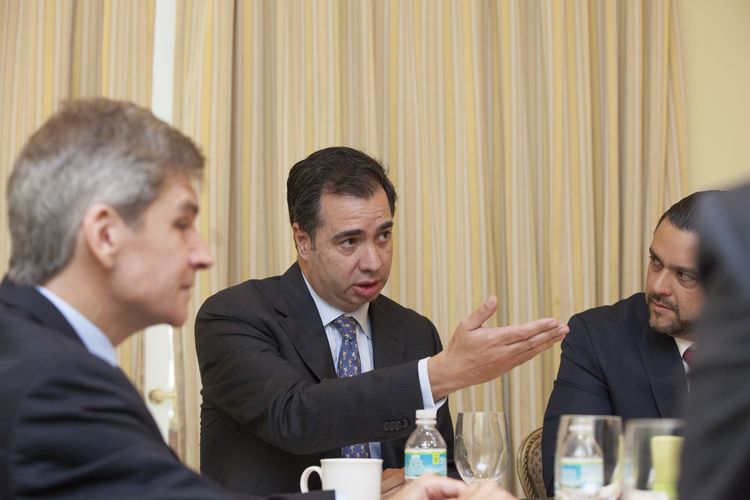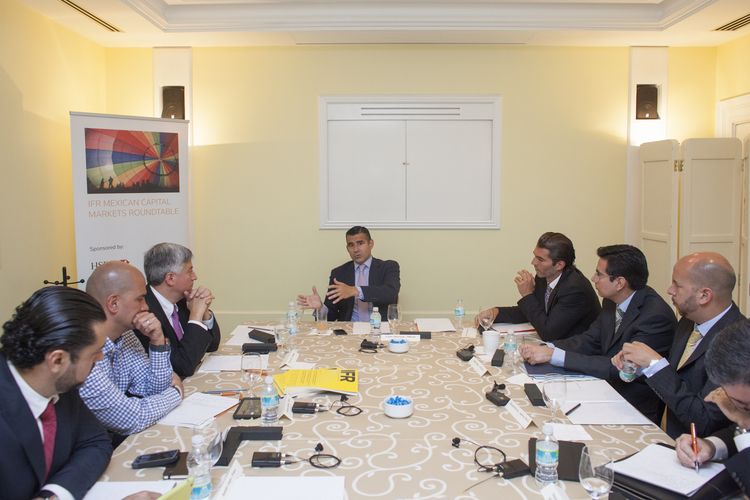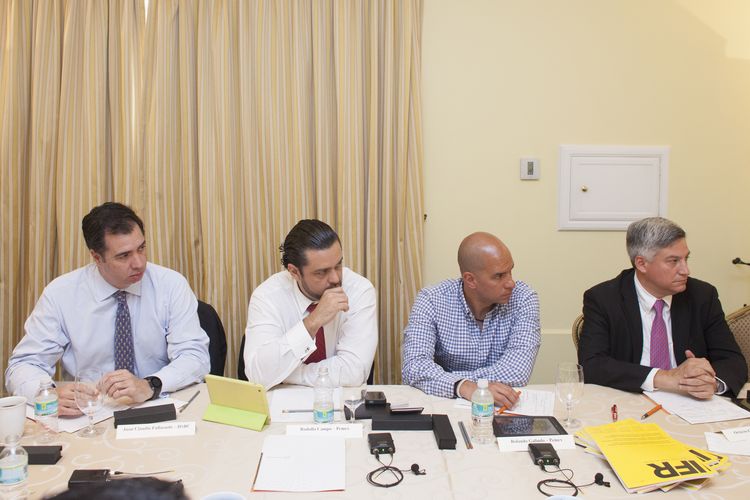To see the digital version of this report, please click here.
To purchase printed copies or a PDF of this report, please email gloria.balbastro@thomsonreuters.com.
IFR: Grupo R was rated BB, but I am not sure if Oro Negro was even rated by a major agency. What is the rating agency perspective on these infrastructure/project deals? What sort of structures do foreign accounts require to play in this market?
Eduardo Uribe, S&P: There is a bright future for infrastructure in energy and in terms of developing ports, airports, and roads. But when you study projects, you have to cover quite simple things like construction and ramp-up risk and who the counterparties are [if you wish to sell these instruments to foreign buyers].
Most of the infrastructure transactions placed in Mexico have been brownfield projects. But these have been bought by the AFOREs and other local investors, probably because the construction risk is over and they know the counterparties. So most of the risks are covered and you are able to get that transaction rated investment grade.
Some greenfield projects have been rated, but only when key risks have been covered by letters of credit or by other counterparties that are willing to accept the risks. So you have to look at the risks that must be covered so that they are bought by foreigners
Locals are willing to assume certain risks that foreigners are not. This is a fundamental part of the work bankers need to do, but once one transaction can be emulated, I think plenty will be placed in the [international] market.
IFR: Can Mexico learn from Brazil’s experience in placing local currency infrastructure bonds among foreign investors. This is a market that really failed to take off, partly because of tax issues but also because of the illiquidity of these instruments.
Albarracin, Milbank: First of all, Brazil doesn’t have a sound and consistent monetary policy. [This stands in contrast to] the Mexican peso, which is a currency benchmark all around the world.
I’m working on a transaction with a Malaysian oil and gas company that is basically hedging exposure in Mexican pesos. No company in the world is hedging themselves using the Brazilian Real because the currency doesn’t have the transparency, and the local currency market doesn’t have the depth that Mexico has.
The currency market in Brazil is very different and it’s not a long-term play for investors. So if you want to do infrastructure financing for Brazil in the international markets, you need to find a way of doing it in a currency that is going to work for the investor base that they are targeting.
[For projects] you often have cash-flows that are basically denominated in local currency and you need long-term financing, but investors don’t have sufficient confidence in the Brazilian currency markets. Look at what has happened in Brazil with the currency depreciation over the last two years. That’s a very clear advantage that Mexico has over Brazil.
Still, like Brazil, there is a role to play for Mexican development banks, which can address some of the risks rating agencies are looking at. No one is going to take construction risk, for example.
That’s a risk that only development banks and governmental agencies will take as they are charged with supporting the development of infrastructure and can provide a solution.
IFR: So what role should the Mexican government play in the development of these instruments?
Diaz de Leon, Ministry of Finance: The model is changing because financial regulation is going to impair the role that banks can play in this. Construction risk could be borne by balance sheets of highly specialised banks that knew the risks, knew who was building what and where. Now that is being lost because regulatory constraints no longer allow banks to do that.
So we have to put in place structures, either through guarantees or some type of enhancements that make risk palatable for the huge investor, which is the institutional investor.
You now have a whole range of investors – from central banks, pension funds, to sovereign wealth funds – that need to put money to work. With compression of yields, they are not getting enough [return] in low-risk investments and they don’t have a huge liquidity constraint.
So they are ideal candidates to bring into these types of structures, and as you mentioned we have a huge agenda in terms of infrastructure. For the next five years, we have around US$600bn in terms of projects. And that excludes the [revamping] of the Mexico City airport.
We need to be creative in terms of how we bring international investors into these projects. I’m sure Pemex will compliment their own funding with some other type of funding for the projects that they need to undertake.
IFR: What about the liquidity? That has been a major hurdle for a lot of these Brazilian infrastructure bonds. Is there a way to address this problem for Mexican issuers?
Fullaondo, HSBC: The only way to address liquidity is to have benchmark sizes. You have to retap the curve in decent size, and recreate benchmarks in the same way Pemex and America Movil have done.
Martinez-Ostos, Barclays: That is a big challenge for these types of transactions. A lot of things have to happen before you get to a US$400m 10-year infrastructure transaction.
It’s becoming much harder for banks to really make markets, because of regulatory constraints, and it is going to be very hard to create that liquidity for specific project bonds, at least in the short-term.
Fullaondo, HSBC: It is the same thing all over the world. It’s not only Mexican transactions. All the infrastructure instruments are fairly illiquid.
Martinez-Ostos, Barclays: I would say that if you have a scenario like we saw in May and June of last year, liquidity disappears – even for deals issued by America Movil and Pemex.
In happy times, there is liquidity. I have my traders send me runs on America Movil, Pemex every hour, but when it gets volatile, you start seeing those runs less often. The bid-offer spread increases and I think that’s what investors complain about.
Albarracin, Milbank: Brazil does not have the euro-peso market. There seems to be more liquidity definitely in the euro-peso market than any other local currency issuances for Latin American companies. That is the key difference.
Mexican companies can do 15, 20 or 25-year bond deals in euro-pesos and there is no other country in the emerging markets where that seems feasible.
Rivera, America Movil: I don’t think going forward there is a real future for euro-peso only transactions. You have a very clear couple of avenues, which are the Global Depositary Notes (GDN), and the Global peso.
I would say the only difference is that the GDN is a certificado bursatil [a local bond] packaged and sold abroad and the Global peso bond is an SEC transaction registered locally that has all the characteristics of a certificado bursatil. Both of those avenues are open to borrowers. However, it’s costly in the sense that you have to report financial information in Mexico and the US.
It solves exactly the situation that Raul is talking about. In bad times, even dollar transactions become illiquid and prices can go everywhere. But the fact that you have access to the entire Mexican investor base, not only the AFORES, makes a difference.
You have insurance companies, investment funds, and even the treasuries of the banks participating in these two types of transactions. So yes, at some point, we’re talking about 30-year transactions. However, we’re going to go through a lot of cycles before we get to that maturity.
Foreign investors will come in very heavily during, as Raul says, these happy times. But we’re going to see other episodes in which international investors are going to take all the risk chips off the table. During those times these securities [global pesos and GDNs] won’t become orphans for lack of investor demand as Mexican investors are still going to continue to always have balance sheets in pesos.
To that extent, even if risk is off elsewhere, Mexican investors will continue investing, because they are growing their assets over the long term.
The solution is to have both investor bases able to buy the same instrument. You have two avenues to do that and it’s just a matter of companies getting used to them. Yes it’s a costlier issuance process because you have to register company information elsewhere. But at the end of the day I think the benefits in the long term [outweigh the costs].
IFR: The tug and pull between local and international investors should also help lower pricing, no?
Rivera, America Movil: It depends when you hit the market. Sometimes, you have seen local pension funds [AFORES] driving prices. Why? Because assets are increasing and there has been little supply in peso denominated debt. During those times, you can get really good pricing. Then you have the other episodes where international investors are less risk averse, probably because of low yields in other currencies, and they are the driver of prices.
It used to be that to get good pricing in Mexican pesos you had to issue certificados bursatiles (Cerburs). The problem is you didn’t get enough size. If you wanted size you needed to go to the international dollar markets.
Now regulators have taken all the steps to allow for [peso] deal with size either through GDNs or global peso bonds. The government has set the standard of how a peso curve is built over time. If companies set themselves the task of executing this, they have the blueprints right there. Anybody can go ahead and do it. It takes time, it takes work, but I think that the benefits by far outweigh the costs.
Albarracin, Milbank: The history of US private placement and 144A markets is not very different. If you go to the US private placement market, it’s like doing a Cerbur [when a handful of pension funds drive pricing].
You have five players – AIG and four other investors – and everyone is trying to dictate terms. Everyone sitting at the table is negotiating the contracts, so the transaction costs and efficiency is horrible and then you have the risk that one investor pulls out or hardens their position and puts the entire deal at risk.
The US private placement market used to be that way and still is, but with the advent of the 144A market as an alternative to the pure – what’s called the 4-2 market in the US – it basically created price friction. Because you have local investors in the US that are regulated, like, insurance companies and pension funds competing with the hedge funds competing with, foreign funds, competing with foreign endowments, competing with sovereign wealth funds. That creates so much price friction that the market dynamics are such that companies have a lot easier time doing deals in those conditions than when you have a captive market of three or four investors that have a lot of leverage. That’s what you are describing in Mexico.
IFR: Pemex opted for GDNs over the Global peso format chosen by America Movil. Any particular reason why you chose the GDN format? Could you perhaps talk a bit about how you have tackled execution risks when trying to raise peso debt.
Campos, Pemex: As Ricardo mentioned, these are the two ways to efficiently attract foreign participation [in the peso bond market]. But I guess at the end we should not invent hot water. The Ministry of Finance has set the pace of how to do this and we are following that lead. We all have a market making programme where financial intermediaries commit to providing the secondary liquidity to investors.
We intend to become more frequent and predictable and that takes a lot of discipline and announcing issuance plans every quarter.
The way we have tackled the situation of having an [investor monopoly dominated by the AFOREs] is to have a defensive strategy that involves issuing a multi-tranche transaction every quarter, where we can issue five-year floating rate notes targeted at mutual funds and banks.
We are also issuing in inflation-linked units called UDIs, which is a bucket that has proven efficient for placement among insurance companies and pension funds.
That defensive strategy has helped us reduce the pressure that local pension funds have asserted on our pricing process. In our case, yes pension funds are the ones setting the price and foreign investors are much more price takers. But it has been cost effective for us
For example, at the moment America Movil’s dollar curve trades 40bp–50bp inside Pemex, but in the case of our peso curve (though that changes a lot) our GDN-eligible 2024 is trading 6bp inside America Movil. So when markets are less volatile, having the pricing process driven by local pension funds is not that bad.
Calvo, Santander: The good is that you can tackle investors with both structures, but the bad thing is that the legal costs of doing this are massive, because you’ve got to pay lawyers in both countries.
The GDN and the Global peso are massively expensive for any regular smaller issuer. So that is why [Euroclearable] certificados bursatiles would be ideal, but we face those hurdles in terms of the tax legislation.
Diaz de Leon, Ministry of Finance: There are some things that are working against liquidity and some in its favour. Against liquidity you have regulation, which is really hampering the traditional role that banks have had as market makers – and we have three banks at the table that are market makers of the Mexican government. The item that works in favour of liquidity is globalisation and how different investors can now express their views more easily through different instruments.
But there is a scale problem. Around the table we have Pemex and America Movil and they can bear that cost of these hybrid structures. But these structures are second best to what I believe is first best, which is making the certificados bursatiles Euroclearable
That would be a huge step in the right direction – allowing foreigners to trade those securities as they trade Mbonos, which currently they can’t because of the withholding tax.
That is something we are really looking into addressing, because that is a key item that would significantly change things, not only for large corporates like the ones at this table, but also for medium and smaller size ones as well.
The other thing that we were thinking about is how to protect the market maker’s role in an environment where balance sheet or capital is more expensive, and where it is more costly for banks to provide that type of service.
The scale of both the corporates at the table means they can have their own market-maker structures, but you would not expect a medium-size corporate to fall back on this type of solution.
We are thinking of alternative ways to provide periodic price discovery for different instruments, and this would apply to either infrastructure bonds or corporate instruments.
Right now we tend to think about liquidity as permanent. However, getting out of any instrument at any time is hard, and you will pay a price for it. We are trying to think about ways of calling for a market, at the secondary level. It would be almost like an initial offering where you can basically call buyers and sellers of a particular instrument with a particular tenor to discover the real price.
At the moment, traders fix the spread and they just look for the underling benchmark and that is how they price on a daily basis. But that does not mean that there is trading at those levels.
IFR: So, how would you create a mechanism like that?
Diaz de Leon, Ministry of Finance: The idea is to tell brokers that we are going to start transacting on, for example, Pemex 2024s in half an hour. That means that potential buyers and sellers can put in their bids and offers, constructing a demand and supply curve to trade large volumes at relatively lower cost.
IFR: So it’s like turning on a liquidity switch?
Diaz de Leon, Ministry of Finance: You can provide this type of mechanism for the least traded securities and that could help provide better liquidity in secondary markets.
To continue reading this roundtable, click the relevant section. Introduction - Participants - Part 1 - Part 2 - Part 3


